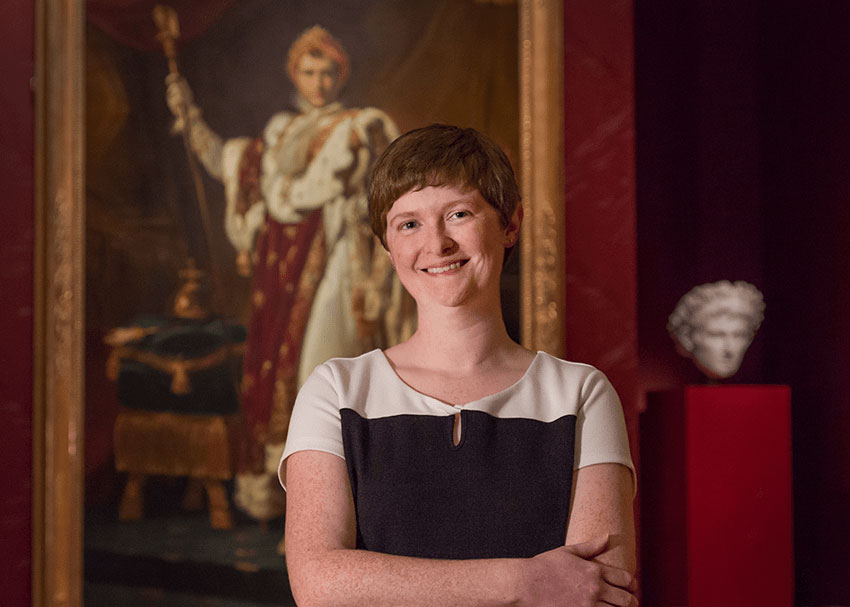
In Napoleon: Power and Splendor at VMFA, more than 200 exquisite works of art include major masterpieces of paintings, decorative arts, sculptures, and engravings, many of which are on view in the United States for the first time. The innovative exhibition offers an up-close encounter with the propaganda machine that modernized and legitimized the reign of Napoleon Bonaparte (1769–1821). Here Dr. Colleen Yarger, VMFA’s Curatorial Assistant for European Art and the Mellon Collections, shares some of her insights into this exhibition, which is curated by Sylvain Cordier, Curator of Early Decorative Arts from the Montreal Museum of Fine Arts. On display in Richmond through September 3, 2018, the exhibition showcases works of art that crafted Napoleon’s image and the Imperial Household that supported his audacious rise to power.
Q: What can visitors expect to see or experience in this exhibition?
A: This exhibition is not your typical Napoleon show. Its premise is to transport us to an imaginary palace and give us a glimpse into the lives of Napoleon and the Grand Officers, who were responsible for running Napoleon’s schedule as well as constructing and maintaining his imperial image.
Q: What do you think people will find the most surprising aspect of this exhibition?
A: The wide range of objects included and how each item contributes to Napoleon’s image—everything in this exhibition has a story. Take for instance, a porcelain plate. In the years after the French Revolution leading up to Napoleon’s empire, the luxury trades (porcelain, tapestries, textiles) had suffered because its clientele had fled France. Upon obtaining power, Napoleon set out to reinvigorate the luxury trades. Throughout the exhibition, you will see the works that Sevres, a luxury porcelain manufacturer, produced to serve as appropriate diplomatic gifts. Not only did these gifts help with diplomacy, but they also very much helped the French economy and gave many people their jobs back.
Q: Tell us about one of the must-see works of art in this exhibition?
A: Ingres’s Dream of Ossian—an enormous painting that was intended to go above Napoleon’s bed in his Monte Cavallo palace in Rome—is a must-see work. It depicts a mythic tale from a James MacPherson poem that Napoleon very much admired (he supposedly carried a copy with him at all times). The opportunity to experience this masterpiece of 19th-century art shouldn’t be missed!
Q: Is there a work of art in the exhibition that really speaks to you personally?
A: In the last room of the exhibition, which is dedicated to Napoleon’s exiles, there is a very large and magnificent birdcage. Of all of the pieces in the exhibition, this one is probably the most unusual—not what people think of when Napoleon’s name is mentioned. This birdcage was the last major work that Napoleon commissioned. It was created by Chinese artisans working on the island of Saint Helena, the location of Napoleon’s second and final exile. Depicted on the sides of the birdcage are traditional Chinese motifs that symbolize longevity, wealth, and rank. The birdcage was rarely used during Napoleon’s lifetime. It also makes one wonder if, perhaps, Napoleon thought of it as a metaphor for his own exile.
Q: If a visitor wants to view related works from VMFA’s permanent collection after viewing the Napoleon exhibition, what one or two works of art would you recommend?
A: Currently hanging in the central bay of the tapestry hall is a significant piece that has a Napoleon connection, Fabre’s The Judgment of Paris (1808). This particular work was created for the 1808 Salon that took place during Napoleon’s empire. Even the frame has motifs that recall those used on the Imperial Household staff uniforms. In the 19th-century gallery, we have the painting Military Event from Napoleon’s First Spanish Campaign (1823) by Bonnefond. This is one of the works that VMFA has that demonstrates that artists continued to be inspired by events during Napoleon’s lifetime after his death.
Q: What do you anticipate will be visitors’ biggest takeaway from this exhibition?
A: That there was a thought-out reason behind everything—every portrait, every plate, every gift, everything. And that the purpose of it all was to glorify the Emperor and solidify his rule. And while it lasted, it was very effective.